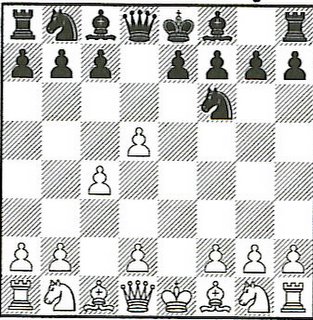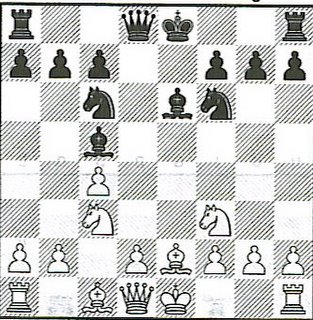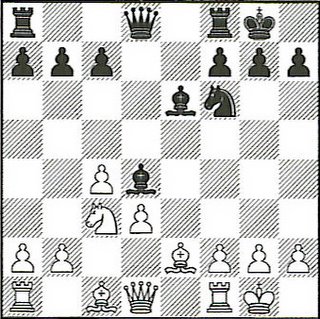On Evil, Wicked Scandy Players - The Game
Ok, here's the game. I've provided some of my own analysis, but have also included Fritz's take on it. Please note that ?'s and !'s are per Fritz and not my own take on them! I say this because one of my moves was awarded !! by Fritz from which I have only gotten on only a couple other games of the many of mine that I have submitted to Fritz for analysis.
NN (1818) - CelticDeath(1493) [B01]
TCCC Normal, IL, 11/15/05
B01: Scandinavian Defence
1.e4 d5 2.exd5 Nf6 3.c4

My opp usually plays Nc3, but has here dared me to play the Icelandic Gambit. I gladly oblige him. 3...e6 4.dxe6 Bxe6 5.Nc3 I like 5. d4 better here, and Fritz agrees. 5...Nc6 I always develop the Nc6 first, but Fritz prefers Bc5. 6.Nf3 Bc5 7.Be2

I thought for a while here. I didn't want to allow 8. d4, but this doesn't bother Fritz. 7...Nd4 [Fritz: 7...0–0 8.d4 Nxd4 9.Nxd4 Bxd4 10.Nb5 Bb6 11.Qxd8 Raxd8] 8.d3 0–0 9.Nxd4 Bxd4 10.0–0

The best move here seemed to be 10 ... c6. The purpose of the move was multi-functional. First, if White develops the bishop to f3, it will bite on granite. Also, the bishop on d4 is safe from an attack by White's Nb5, forcing it to move from it's primo post. Finally, it allows my queen to have access to the queenside. 10...c6 11.Kh1 I think Kh1 was too passive a move. 11...Qd7 12.f3 Rad8 13.Bg5 Qc7

14.Qe1 [My opp didn't like the following line, which is still about equal. 14.Ne4 Nxe4 15.Bxd8 Nf2+ 16.Rxf2 Rxd8 17.Rf1=] 14...Rd7 15.Rb1 a5 16.Ne4 Nxe4 17.dxe4 Qe5 18.Qc1 f5 19.Bf4 Qf6 20.Qc2 fxe4 21.fxe4 Qg6 22.Bg3 Rdf7 23.Rxf7 Rxf7[Fritz: Weaker is 23...Kxf7 24.Bd6 Rd8 25.c5±] 24.Rd1 c5 25.b3 Rf6 Short on time, my opp makes a critical error. 26.Bd3?? [Fritz: 26.Rf1= was possible]
And now, the critical position (from my last article)

26...Qxg3!!–+ 27.e5 [Fritz: 27.hxg3 Rh6# A classical mating theme] 27...Rh6 28.Bxh7+ [Fritz: 28.h3 doesn't do any good 28...Bxh3! Demolishes the pawn shield 29.Bxh7+ Kh8 30.Rxd4 Bxg2+ 31.Kg1 Rh1#] 28...Kh8 [Fritz: 28...Rxh7?! is easily refuted 29.Qxh7+ Kxh7 30.hxg3–+] 29.h3 Bxh3! 30.Rd3 [Fritz: 30.gxh3 Rxh3+ A beautiful mate combination] 30...Bxg2# 0–1
1. e4 d5 2. exd5 Nf6 3. c4 e6 4. dxe6 Bxe6 5. Nc3 Nc6 6. Nf3 Bc5 7. Be2 Nd4 8. d3 O-O 9. Nxd4 Bxd4 10. O-O c6 11. Kh1 Qd7 12.f3 Rad8 13. Bg5 Qc7 14. Qe1 Rd7 15. Rb1 a5 16. Ne4 Nxe4 17. dxe4 Qe5 18. Qc1 f5 19. Bf4 Qf6 20. Qc2 fxe4 21. fxe4 Qg6 22. Bg3 Rdf7 23. Rxf7 Rxf7 24. Rd1 c5 25. b3 Rf6 26. Bd3 Qxg3 27. e5 Rh6 28. Bxh7+ Kh8 29. h3 Bxh3 30. Rd3 Bxg2# 0-1
NN (1818) - CelticDeath(1493) [B01]
TCCC Normal, IL, 11/15/05
B01: Scandinavian Defence
1.e4 d5 2.exd5 Nf6 3.c4

My opp usually plays Nc3, but has here dared me to play the Icelandic Gambit. I gladly oblige him. 3...e6 4.dxe6 Bxe6 5.Nc3 I like 5. d4 better here, and Fritz agrees. 5...Nc6 I always develop the Nc6 first, but Fritz prefers Bc5. 6.Nf3 Bc5 7.Be2

I thought for a while here. I didn't want to allow 8. d4, but this doesn't bother Fritz. 7...Nd4 [Fritz: 7...0–0 8.d4 Nxd4 9.Nxd4 Bxd4 10.Nb5 Bb6 11.Qxd8 Raxd8] 8.d3 0–0 9.Nxd4 Bxd4 10.0–0

The best move here seemed to be 10 ... c6. The purpose of the move was multi-functional. First, if White develops the bishop to f3, it will bite on granite. Also, the bishop on d4 is safe from an attack by White's Nb5, forcing it to move from it's primo post. Finally, it allows my queen to have access to the queenside. 10...c6 11.Kh1 I think Kh1 was too passive a move. 11...Qd7 12.f3 Rad8 13.Bg5 Qc7

14.Qe1 [My opp didn't like the following line, which is still about equal. 14.Ne4 Nxe4 15.Bxd8 Nf2+ 16.Rxf2 Rxd8 17.Rf1=] 14...Rd7 15.Rb1 a5 16.Ne4 Nxe4 17.dxe4 Qe5 18.Qc1 f5 19.Bf4 Qf6 20.Qc2 fxe4 21.fxe4 Qg6 22.Bg3 Rdf7 23.Rxf7 Rxf7[Fritz: Weaker is 23...Kxf7 24.Bd6 Rd8 25.c5±] 24.Rd1 c5 25.b3 Rf6 Short on time, my opp makes a critical error. 26.Bd3?? [Fritz: 26.Rf1= was possible]
And now, the critical position (from my last article)

26...Qxg3!!–+ 27.e5 [Fritz: 27.hxg3 Rh6# A classical mating theme] 27...Rh6 28.Bxh7+ [Fritz: 28.h3 doesn't do any good 28...Bxh3! Demolishes the pawn shield 29.Bxh7+ Kh8 30.Rxd4 Bxg2+ 31.Kg1 Rh1#] 28...Kh8 [Fritz: 28...Rxh7?! is easily refuted 29.Qxh7+ Kxh7 30.hxg3–+] 29.h3 Bxh3! 30.Rd3 [Fritz: 30.gxh3 Rxh3+ A beautiful mate combination] 30...Bxg2# 0–1
1. e4 d5 2. exd5 Nf6 3. c4 e6 4. dxe6 Bxe6 5. Nc3 Nc6 6. Nf3 Bc5 7. Be2 Nd4 8. d3 O-O 9. Nxd4 Bxd4 10. O-O c6 11. Kh1 Qd7 12.f3 Rad8 13. Bg5 Qc7 14. Qe1 Rd7 15. Rb1 a5 16. Ne4 Nxe4 17. dxe4 Qe5 18. Qc1 f5 19. Bf4 Qf6 20. Qc2 fxe4 21. fxe4 Qg6 22. Bg3 Rdf7 23. Rxf7 Rxf7 24. Rd1 c5 25. b3 Rf6 26. Bd3 Qxg3 27. e5 Rh6 28. Bxh7+ Kh8 29. h3 Bxh3 30. Rd3 Bxg2# 0-1

6 Comments:
hey, it was white e5, just one move too late! Lol. I haven't had time to run through the game on my computer, just have been following your annotations. What is your assessment of white's d3 instead of d4? That seems like quite a weakening move, giving you the hole at d4 and a nice place for your bishop. What I know of the Icelandic, and that's not much but it's something, is that d4 is the main line.
I kind of view that weak d pawn as my compensation for the gambited pawn. Basically, then, I either build enough pressure on the d pawn to win it back, or transfer (using my development advantage) the attack elsewhere. My opp apparently felt he could hang onto the pawn and withstand my attack. However, the position soon became so difficult for him that he got into time pressure and missed the tactic that won the game.
I always seek for a possibility to play Qe7 and O-O-O. Gives wild play with lots of opportunities for black.
Often white has to answer Qe2, clogging up the white pieces and postponing his castling.
Tempo, yep, I've done that before, too, in other games. That's usually if White has moved his d pawn to d4. I tried a different strategy this time.
Going through the whole game it's totally understandable how he missed the Queen takes Bishop heading into mate threat. No blunders, a fairly even position, playing for small advantages move after move... I doubt I would see it if I were White.
I really don't like his opening variation choice. I think you did well to aggressively equalize early.
I've played the Scandy against him before, and he usually plays 3. Nc3. He might have been expecting the Scandinavian Gambit this time (3. ... c6), because I'm pretty sure I've played that against him with less than spectacular results.
Post a Comment
<< Home